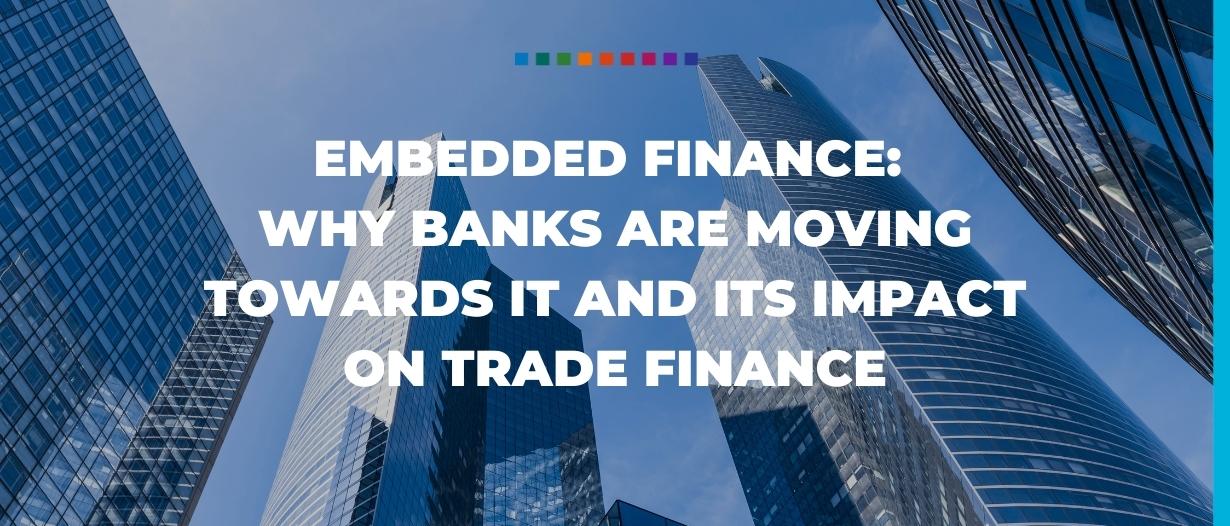Embedded finance has leapt onto the global financial stage in recent years. While many of us encounter this innovative form of financial services in our daily lives, few have likely really taken notice.
And that’s just the point.
Let’s dive into embedded finance, learn what it is, why banks are moving towards it, and how this growing trend can impact trade finance.
Embedded finance – Explained
In embedded finance, financial tools or services – like lending or payment processing – are used by a non-financial provider.
Financial processes can be streamlined through embedded finance, making it easier for consumers to access services when they need them.
Think back to a substantial purchase you may have made in the past – maybe you were buying that snazzy new sectional sofa to round out your living room.
Back then, you may have needed to go to a physical bank branch and apply for the credit that you would need to make the purchase with the furniture store.
Now with embedded finance, you can make a purchase and get credit in one place: the point of service – in this case, the furniture store.
Many online shoppers in the UK today have heard of services like Afterpay or Klarna that allow purchasers to pay for their order in a few interest-free installments.
This is a prime example of embedded finance in action. The financial service of providing credit is so seamlessly ‘embedded’ into the online services we already use that it just feels like part of the experience.
This buy now, pay later system, however, is just one of many different examples of embedded finance in action.
Another popular type is point-of-service lending.
While similar in concept to the buy now, pay, later system, point-of-service lending takes things a step further, by allowing businesses to directly embed financial tools that allow them to finance even more significant purchases.
In order for them to lend responsibly, they need additional information, such as creditworthiness information.
Yet another common example is integrated insurance.
When making major purchases, many customers will want to protect against potential loss or damage to their newly acquired goods.
Imagine the headache you could save as a consumer if you could click a few extra buttons and insurance is taken care of – all without ever having to leave the dealership or pick up the phone.

Embedded finance provides banks with an opportunity to develop a low-margin, high-volume revenue stream.
Historically, however, they have been hesitant about the prospect of distributing their products through partner organisations, fearing that such a practice would damage their client relationships.
The reality is to the contrary. End-users love the convenience and simplicity that embedded finance applications bring to their lives, and it seems that the trend is only going to continue.
To meet the rising demand for embedded finance, financial institutions are increasingly providing bundled “banking as a service” (BaaS) offerings.
These are usually white-labelled or co-branded services that non-banks connect to through an API and use to directly serve their own customers.
Providing these BaaS offerings to clients requires a bank to have already acquired a certain degree of digital capabilities.
McKinsey estimates that around two thirds of banks have undergone the digital transformation necessary for this.
The combination of this increased internal digital ability and the growing demand from users externally create the perfect conditions for banks to move towards embedded finance.
What about ‘embedded trade’
Many experts remain optimistic that embedded finance could help close the $1.7 trillion trade finance gap.
One of the many contributing factors to this gap is the current disconnect that exists between the physical and the financial supply chains.
For half of the world’s countries, inadequate trade finance measures rank among the top three export barriers, according to the World Economic Forum.
In addition to encouraging trade growth, making progress in this area will also promote economic development.
Embedding financial services into the trade ecosystem will link more parties within the value chain and enhance the whole trade process.
This is because it will embed the flow of funds with the logistical components of moving goods from one point to another.
Funds could be exchanged at various points in the logistical trade process, easing some of the upfront burdens that financiers face in the trade finance process.
As increasingly more progress is made towards trade digitalisation, embedding financial tools into these platforms will become less difficult and the benefits more pronounced.
Bundled services in trade, or ‘embedded trade’, could include integrating the physical and financial supply chain, digitising paper documents such as bills of lading, and streamlining the financing process.

Challenges for embedded trade finance
Despite all of the progress that has been made in recent years, global trade on aggregate still lags behind in terms of digital readiness.
This means that many of the benefits that firms could realise from embedded finance tools will be offset by larger onboarding costs to become digitally active in the first place.
On top of this, many jurisdictions around the world still do not recognise digital documents as legally binding, adding an extra layer of complexity when trying to use such digital documents as a trigger for embedded finance activities.
Overall, embedded finance has taken the world by storm in recent years, and seems to be here to stay.
Customers are drawn to the convenience that these services provide and businesses are always striving for ways to remain ahead in the hyper-competitive landscape.
When it comes to trade finance, embedded finance has the potential to align the disconnected physical and financial supply chains.
As the entire trade ecosystem becomes more digitalised, this alignment may be a major factor in opening more financing opportunities for small and medium-sized enterprise (SMEs), and may ultimately narrow the global trade finance gap.

































